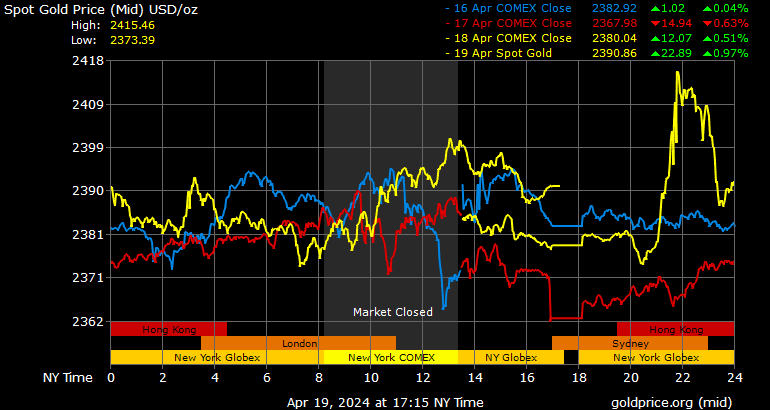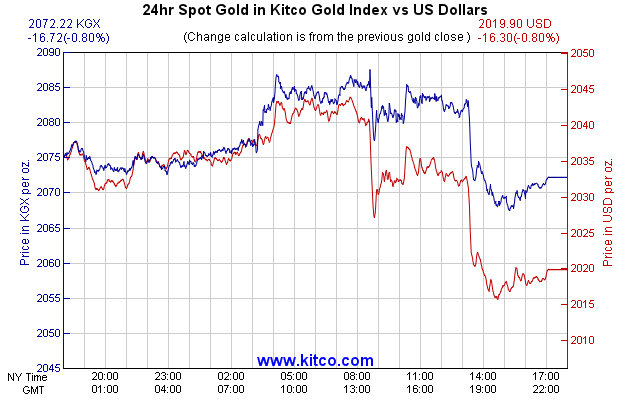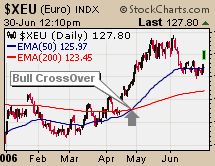This post is a guest contribution by Dian Chu*, market analyst, trader and author of the Economic Forecasts and Opinions blog.
Gold fell for the first time during last week, off 4% on Friday to $1,162.40 an ounce, the biggest drop since Dec. 1, 2008 after the new U.S. jobs data showed unexpected strength. The Dollar rallied against rival currencies while traders reversed the “Sell Dollar/Buy Gold” strategy. (Fig. 1)
The Dollar’s decline has been a key factor in the record rising gold price this year by boosting the metal’s appeal as an alternative investment along with other commodities and high-yielding currencies.
Though gold briefly touched a low of $1,136.80 during the Thanksgiving week on fears of a possible debt default in Dubai, the precious metal had otherwise continued its vertical ascend into uncharted territory advancing in 21 of the past 23 sessions.
While gold has some underlying support from central banks and investment funds, there are some indications suggesting gold is moving mostly on momentum, and that a deeper correction may be due.
India Leading the Gold Rush
Gold’s rally in the past couple weeks was largely on speculation that India’s central bank may buy more gold from the IMF adding to the 200 ton purchase it made last month.
This second purchase by India would be the fourth central bank sale this quarter of IMF bullion. The three prior sales were Sri Lanka’s $375 million purchase of 10 metric tons; India’s initial $6.7 billion purchase 200 metric tons, and Mauritius bought 2 tons for $71.7 million.
The three sales so far leave about 190 tons up for grabs from the 403.3 tons the IMF announced Sept. 18 it would divest to shore up its finances.
China, The New King of Gold
Private Chinese gold buying, for both jewelry and investment, will overtake Indian demand this year, predicts metals consultancy Gold Fields Mineral Services (GFMS). China is now the world’s No.1 gold mining nation. The People’s Bank is widely thought to have grown its gold reserves by buying domestic production direct.
In addition, China has cut the import tax on jewelry and allowed select commercial banks to sell gold bars, and gold is now traded freely on the Shanghai Gold Exchange.
Russia & Vietnam Not Far Behind
On Nov. 23, Russia’s central bank announced it had bought 15.6 metric tons of gold in October and has said it aims to increase gold’s share in its reserves this year to keep its investments diverse. The Russian central bank had been steadily building its gold stocks this year, which has been up 17% since Jan. 1 to 606.5 tons.
The Vietnamese central bank has also granted quotas to import 10 tons of gold for use by its banking system and gold traders.
Low Interest Rate with Worthless Paper
Some analysts attribute the most recent rally to the reversal of a decades-long selling of gold by developed economy central banks to net buying by emerging market authorities.
Gold accounts for 9% of reserves held by central banks (valued at market prices). Therefore, it is logical for central banks stocking up on gold as it does bring the much needed diversity due to gold’s low correlation with key currencies and its strong inverse correlation with the US Dollar.
However, diversifying reserves primarily via gold rather than other currencies partly suggests the expectation of interest rates around the world to stay low for a long time. Moreover, it reflects central bankers’ growing distrust of all paper currencies, not just the Dollar.
Surging Derivative Trading
Some of the world’s most successful traders, including John Paulson, David Einhorn, and Paul Tudor Jones, have positions in gold or gold related investments. Pension funds allocate about 5% as protection against the weakening Dollar. Hedge funds and traders are piling into gold futures markets around the world, lured by the record-high prices in the precious metal.
Based on the Commitment of Trader (COT) report as of November 24 by the U.S. Commodity Futures Trading Commission (CFTC), the number of long positions in gold was around 370,000, up about 5,000 from just a week ago, mostly from non-commercial short-term speculative investors.

It is also interesting to note CFTC Nov. 2009 monthly report shows that while commercial participants held net short positions; non-commercial and other participants, who accounted for 51.4% of open interest, held net long positions,. Some traders already indicated there has been some good upside buying in March and April in the $1,300s and even $1,400s.
Overall, NYMEX Gold futures open interest increased 4.8% in November with longs outnumbering the shorts by 71% to 12%. This would have been the highest number of long speculators in the history of the New York gold market since 1975, except for last year when the gold hit $1,030. (Fig. 2)
High number of speculative positions is the driving force of the commodities rally in general, but that also makes gold vulnerable to further corrections as well as high volatility.
Diminishing Physical Demand
Regardless of the gold fever this year, according to the third quarter 2009 Gold Demand Trends Report from the World Gold Council, demand reached 800.3 tons, representing a drop of 34% year-over-year. The report also found that average gold prices for the quarter were 10% higher than in the same quarter last year.
Diminishing physical demand coupled with higher price suggests it has been mostly speculators that are driving up the price. In addition to central banks using gold to rid Dollar dependency, fund managers and speculators also have been driving up the price of gold, partly seeking protection from potential inflation in a low interest rate environment.
Fear Factor
Gold is a commodity that perception plays a more significant role than other market factors. Almost all other commodities such as crude oil, natural gas, copper, prices often fluctuate on indications of inventory, supply, and demand; whereas gold moves primarily with investor’s fear or perception of inflation, U.S. Dollar and the economy.
But just as fast as the market perception can drive prices straight up, it could tank an asset class in a matter of minutes. As discussed here, investment/speculator demand is clearly a major factor in the current gold price rally, a decline could potentially take the gold price down quite significantly on indications such as rising interest rate, or the U. S. Dollar starts to strengthen.
If history is any indication, after gold rose sharply in 1979-1980 to $850, it was followed by a drop to near $500 in less than 2 months. It is conceivable that gold could take a similar loss in a short time.
Short-term Outlook
The general expectation is that the Federal Reserve will not act in favor of the Dollar until later next year. Gold and Dollar correlation is still highly negative, but one should expect a fair amount of volatility given the uncertainty of global economic direction intensified by the Dubai crisis. In that sense, gold could certainly challenge the $1,225 levels again, with $1080, $1050 and $1025 each represents significant support level.
Technically Overbought
Friday’s pullback has moved gold’s MACD to the downside and the 14-day Relative Strength Index (RSI) back in the neutral territory (Fig. 1), which could spur more selling if Dollar retains its strength.
Though gold’s longest rally (nine days) since 1982 ended last Wednesday, the precious metal is racking up a near 35% gain on the year, and moved up almost 17% this month alone, heading for the sharpest annual increase in two decades.
So, at this level, gold has also run into profit-taking, as well as year-end fund manager’s portfolio repositioning. Closes below the 20-day moving average crossing would likely confirm that a short-term top has been posted.
Long Term Bullish Intact
Sporadic green shoots of economic data could obscure the harsh reality, and lead to gold weakness in the short term. Nevertheless, there’s enough momentum around for gold to make new highs as long as the Dollar stays weak spurring further safe haven demand on concerns about a double dip recession.
Therefore, the potential exists for a large rise in the longer term. However, if this rally extends into uncharted water on momentum without a healthy enough correction, upside targets will be hard to project with the eventual correction equally difficult to predict, just as they say, “The higher you climb, the harder you fall.”
*Dian Chu, Market analyst, trader and financial writer for Seeking Alpha, Zero Hedge, Daily Marksts, iStockAnalyst & StraightStocks. My articles also appear in Reuters, USA Today and BusinessWeek, etc. Professional credentials include M.B.A., C.P.M. and Chartered Economist with extensive professional experience in market segment forecasting and strategies. Previous employers include Enron, Time Warner & Clear Channel. I’m currently working in the U.S. for the energy sector.
Source: Dian Chu, Economic Forecasts and Opinions, December 6, 2009.
--------------------------------------
Paksu : Be cool with this situation, the overbought gold will return in bull pipe with 2-4 days.





















No comments:
Post a Comment